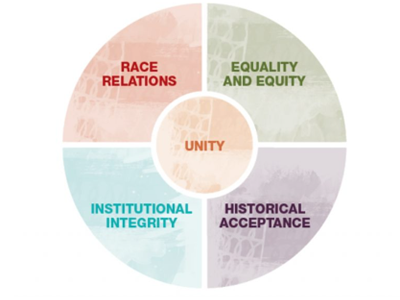Reconciliation progress
Year level: 9
Strand: Statistics
Lesson length: 75 mins
Students explore the notion of reconciliation in Australia analysing a report – Reconciliation Australia’s Australian Reconciliation Barometer to answer an inquiry question for their statistical investigation.
This lesson was developed in collaboration with Caty Morris and Aboriginal and Torres Strait Islander Mathematics Alliance (ATSIMA).

Curriculum information
Achievement standard
Students compare and analyse the distributions of multiple numerical data sets, choose representations, describe features of these data sets using summary statistics and the shape of distributions, and consider the effect of outliers.
Content descriptions
Students plan and conduct statistical investigations involving the collection and analysis of different kinds of data; report findings and discuss the strength of evidence to support any conclusions (AC9M9ST05)
General capabilities
Numeracy
- Interpreting and representing data (Level 8)
Digital literacy
- Interpret data (Level 6)
Critical and Creative Thinking
- Develop questions (Level 6)
- Identify, process and evaluate information (Level 6)
- Interpret concepts and problems (Level 6)
- Draw conclusions and provide reasons (Level 6)
Ethical understanding
Cross-curriculum priority
Aboriginal and Torres Strait Islander Histories and Cultures (A_TSIP1)
Assessment
Create an infographic
- Provide students with a relevant digital infographic creation tool such as Canva (Education version).
- As a group students use their collated information and supporting statistics to back up their claim.
- Assess students proficiency in describing features of their data sets and use of summary statistics.
Prerequisite student knowledge and language
Prior to this lesson, it is assumed that students:
- have an understanding of the term reconciliation
- can interpret data represented in tables and charts
- use a range of data visualisations such as 100% stacked bar charts
- have familiarity with spreadsheet software and creating charts.
Provide students with the Reconciliation Student Toolkit for students who are new to the concept of reconciliation. The guide within the toolkit will help to support the prerequisite/assumed knowledge and the success criteria around knowing how they can get involved.
Areas of challenge
Some students may:
- not understand what reconciliation is or its complexity
- have limited use or familiarity with spreadsheet software such as Excel for Word or Numbers for for iOS and macOS
- not understand differences in data, data representations and how they can be successfully compared and analysed to draw conclusions.
What you need:
Lesson plan (Word)
Teacher's slides (PowerPoint)
Sample spreadsheet (Excel)
Access to internet and computers or devices with spreadsheeting software
Learning goals
Learning intention
- We are learning to investigate data in reports relating to the state of reconciliation in Australia.
- We are learning to gain awareness of attitudes towards reconciliation and the social issues around reconciliation.
- We explore the reconciliation process using reported data.
Success criteria
By the end of this lesson, students can:
- interpret and draw conclusions from data visualisations
- plan and conduct a statistical investigation
- understand the process of reconciliation in Australia and how they can be involved in it.
Why are we learning about this?
This investigation provides students with the real-life context of reconciliation in Australia, and how they can contribute to it. It incorporates the Aboriginal and Torres Strait Islander Histories and Cultures cross-curriculum priority into mathematics, that is, where statistics and data can be investigated to learn through a social justice lens.
Learning hook 10 mins
- Download and use the teacher’s slides to accompany your teaching. You will find this in the ‘What you need’ section.
Introduction
- Introduce students to the topic of reconciliation in Australia and its importance using the teacher’s slides (slides 2-3).
Learning hook
- Present students with the inquiry question: Has progress been made on reconciliation in Australia?
- Use slides 4-5 to explain that students will undertaking a statistical analysis using data presented in the 2022 Australian Reconciliation Barometer (ARB) report, published by Reconciliation Australia, an independent not-for profit organisation and lead body for reconciliation in Australia. Briefly explain the intention behind the report and that the 2022 report provides data across years 2014-2022.
- Use slide 5 to introduce the 5 dimensions of reconciliation, revealing each one using a mouse click. The ARB provides data and an analysis organised around these five key areas.
- Use slide 6 to explain the statistical investigation and the inquiry question.
Explore 60 mins
Familiarise (data visualisations) 15 min
- Introduce several ways data is visualised in the report so that students are familiar with the types of charts and the types of data used to create them. Slides 7-16 provides examples of data extracted from the report presented firstly as a table, and next on the following slide, the way the data is visualised in the report. Use the slide notes as a guide to form discussion of the different visualisations and draw conclusions from the data presented.
- Provide these two resources Evaluating Resources Guide and Terminology Guide to support discussing/engaging with reconciliation themes.
Statistical investigation (45 min)
- Present the task of the statistical investigation and the process of acquiring relevant data and statistics extracted from 2022 Australian Reconciliation Barometer (ARB) report (slide 17).
- Provide access to the report and organise students to work in collaborative groups to divide the task into manageable parts.
- Students familiar with spreadsheeting software can create their own charts and data visualisations using data from the report. A sample spreadsheet provides examples of data extracted from the report that was used in the teacher’s slides. You may decide to conduct a small teaching group to provide basics of using a spreadsheet for students who require support.
- As a group students decide on the information and supporting statistics to use to back up their claim. They collate the information to use in the assessment task of creating an infographic conducted in a follow-up lesson.
Summary and reflection 5 mins
- Students discuss the inquiry question.
- Select several groups to make their claims and justify their response with relevant statistical information.